Western Digital VelociRaptor 1TB (WD1000DHTZ) Review
by Anand Lal Shimpi on April 16, 2012 8:00 AM EST- Posted in
- Storage
- HDDs
- Western Digital
- VelociRaptor
Random Write Speed
The VelociRaptor's two primary strengths are its 2.5" platter size and 10,000 RPM spindle speed. The combination of the two delivers some of the best random access times you can get from a mechanical hard drive, at least one aimed at the desktop. Indeed we see a tangible performance advantage not only over the latest 3.5" hard drives, but also the previous generation VR. The advantage of the NAND equipped Seagate Momentus XT is just as large.
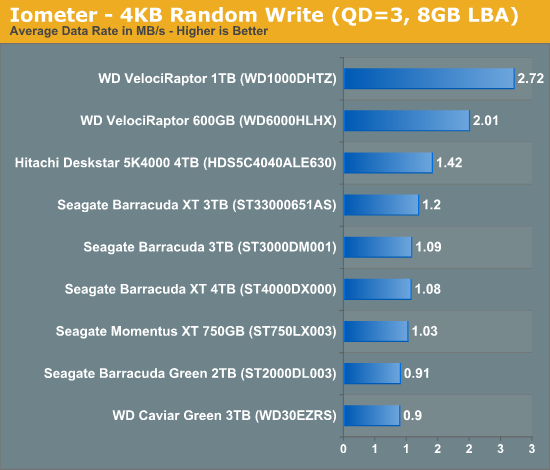
Obviously even the most affordable SSDs deliver better random IO performance compared to the VelociRaptor as you can see by looking at Intel's SSD 320 here:
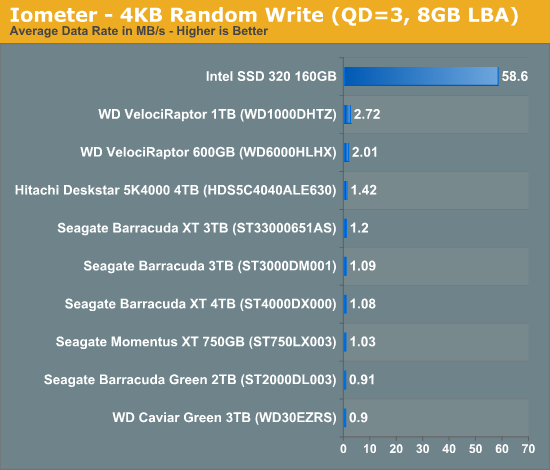
The new VelociRaptor manages a 35% increase in 4KB random write performance over its predecessor, and more than double the performance of Seagate's 7200RPM Barracuda XT. Unlike SSDs, random read and write performance is symmetric on most hard drives so we only really need to look at a single value here. Intel's SSD controllers have typically offered very high random IO performance, so the SSD advantage here isn't unusual.
Ultimately it's this 21x gap in random IO performance that really contributes to why SSDs feel so much faster than mechanical drives. Client workloads aren't purely random in nature (which is why we confine our client random write tests to an 8GB LBA space), but sprinkle non-sequential accesses in the middle of otherwise sequential transfers and mechanical disk performance drops significantly. Small file requests while launching an application, updating file tables, writing to logs, are all examples of small, pseudo-random IO that happen in the background, which can make overall HDD performance drop significantly. While it's true that most client workloads don't require the sort of random IO performance a high-end SSD can provide, it's the additional headroom that SSDs offer that allow performance to remain high regardless of what's going on in the background. We can look at this data another way, instead of average data rate let's look at the maximum number of IO operations these drives can service in a single second:
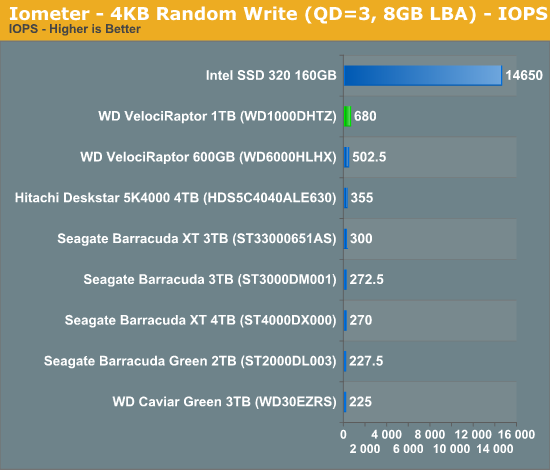
Based on this list, the average hard drive (excluding WD's 10,000 RPM drives) is capable of handling around 275 4KB pseudo-random write operations per second. Clearly that's not sufficient for the majority of client workloads because once you load up full disk encryption, real time virus checking, background email/IM, backup software and go about your normal application usage you always run into IO limited periods where you're waiting on your drive to finish crunching. Upping the spindle speed to 10,000 RPM gives you a bit of a reprieve, more than doubling performance, but that's not always sufficient given the workload.
At the other end of the spectrum we have a stanard 3Gbps SSD, capable of servicing nearly 15,000 4KB write operations per second. No desktop application could be shipped that required this type of IO performance as it would be unusable on any hard drive. The added performance in the case of an SSD doesn't deliver 21x the performance of a VelociRaptor, but it offers enough performance headroom that applications and file accesses will remain as fast as possible regardless of what's going on in the background. SSDs use their headroom to offer a consistent IO experience, regardless of workload.
Sequential Read/Write Speed
Sequential performance is easily improved by increasing platter density, buffer sizes and pushing for more aggressive prefetch in the drive's controller. As a result, the SSD advantage isn't nearly as significant. Furthermore, the new VelociRaptor delivers such a large increase in sequential speed that it's able to approach the performance of 3Gbps SSDs:
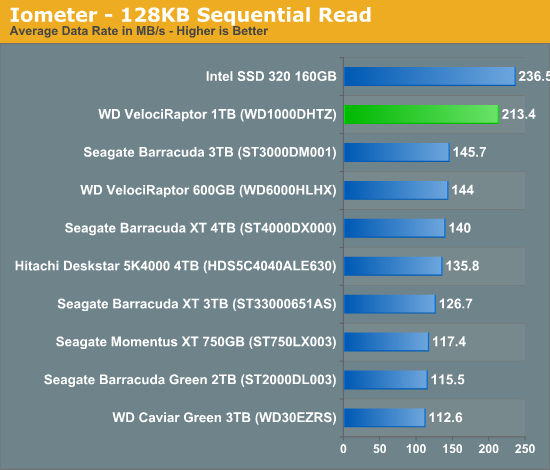
It's because so much of client workloads are sequential in nature that some users don't really feel a dramatic difference in going from a hard drive to an SSD. The only thing I can add is that the users who are constantly frustrated by the speed of their hard drive will be the ones to most appreciate the move to solid state storage. Shifting focus back to the VelociRaptor however, its sequential read speed is quite competitive with mainstream 3Gbps SSDs. Start comparing to 6Gbps drives and the VR is significantly outgunned.
Again, reads and writes don't vary with the VR but compared to the 160GB Intel SSD 320 there's a shift in the standings:
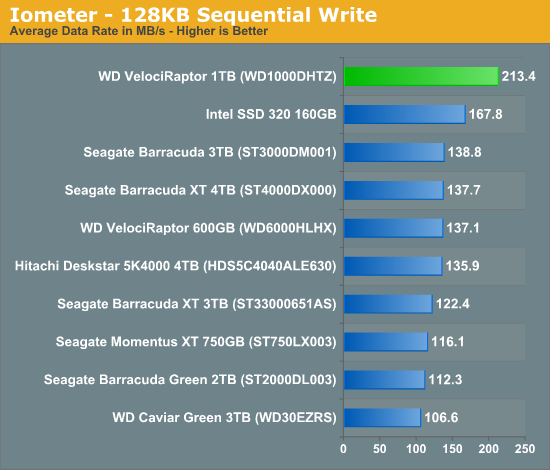
Again, compared to larger or faster SSDs the VelociRaptor would surely lose, I tried to pick an SSD that was more representative of what you could get on a budget or with an older drive. Either way the gains over other mechanical drives are respectable, the new VR definitely delivers in sequential speeds as far as hard drives are concerned.
Performance Across All LBAs
Although logical block addressing works linearly, hard drives are made up of one or more circular platters. Platters are written from the outside inward in order to maximize performance (you cover more data in a single rotation of an outer track vs an inner track). I used HDTach to characterize the new VelociRaptor's performance across all LBAs:
The inner most tracks on the VelociRaptor are still accessible at 123MB/s - faster than any 3.5" drive we've tested here. One benefit to using 2.5" platters is remarkably consistent performance across all tracks. Average performance across all tracks is 173MB/s.


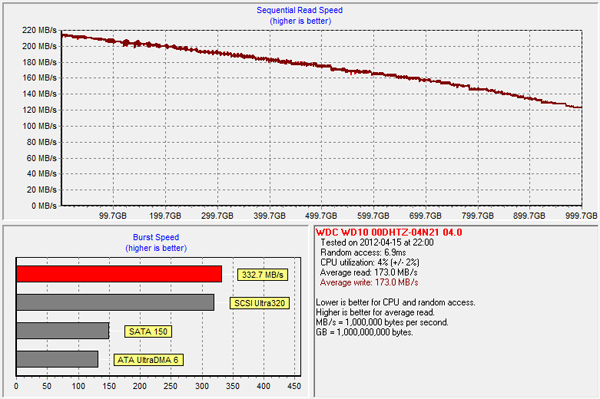








92 Comments
View All Comments
JNo - Monday, April 16, 2012 - link
Meh.This drive line sadly is like a dinosaur in more than just one way...
Honestly not trolling and I still own a 60GB raptor myself but we're in a new era where I find it hard to understand what this brings to the table. I'm not saying *someone* might need it but you'll almost always do better with small SSD + HDD or an SSD acting as cache for a cheap HDD.
Metaluna - Monday, April 16, 2012 - link
I think a lot of OEMs and enterprises shy away from multi-drive setups because of the perception that they are harder to set up and manage than just having everything on one big drive, especially if you are trying to support naive users who tend to splatter files all over the place, particularly for Windows installations.Plus, as far as I know, the only company that supports SSD caching is Intel, so you need their chipsets and their drivers, which only work on Windows.
Then you have laptops, which only have one physical drive bay usually, but this drive won't fit in them anyway so that's a moot point.
gwolfman - Monday, April 16, 2012 - link
@AnandTech:Please short stroke an affordable, yet high performance HDD to a 1TB capacity (e.g., a 3TB HDD short-stroked to 1TB) and compare performance. I'd wager a bit that the short-stroked HDD would perform equal to or better than the new Raptor. ;) Please, pretty please!?!
bollwerk - Monday, April 16, 2012 - link
I don't see why anyone would buy one of these for ~$300, when you can get a 750GB Momentus XT for ~$150.kyuu - Monday, April 16, 2012 - link
Agreed. The Momentus XT outperforms the Velociraptor in the more meaningful benches, can be put into a laptop, runs quieter and cooler (by far), and is half the $/GB. If you need the faster sequential speed, you can RAID0 two Momentus XTs, pay the same price as one of these and get better performance and more capacity.Or, y'know, just get an SSD and pair it with a normal HDD (or pair your SSD with a Momentus XT, like I did).
By not including some form of NAND caching, Western Digital doomed these drives to obsolescence before they were even released.
I'm wondering when Seagate is going to get around to releasing the new Baracudda XT so we'll have a 3.5" HDD with NAND caching for desktops, although even the older 500GB Momentus XT is doing a bang-up job as the companion HDD to my SSD in my desktop rig.
Jeff7181 - Monday, April 16, 2012 - link
This sucks. Should have included at least 20 GB of NAND.
marraco - Monday, April 16, 2012 - link
Anand, please do a roundup of PCI/PCI-e cards with Sata 6gbps expansion. My mother is an x58, and the only fault it haves is lack of SATA III support.Is not worth upgrading the mother, memory and processor just to update SATA, and there is little information on SATA cards.
Nihility - Monday, April 16, 2012 - link
I'm in the same boat.Got 2 SSDs hooked up to SATA 2. It's such a waste :(
LordConrad - Monday, April 16, 2012 - link
Two of these new VelociRaptors in RAID 0 would be awesome for video editing. Great performance without thrashing the life out of an SSD.twotwotwo - Monday, April 16, 2012 - link
The 3.5" form factor is really 101.6mm wide (says Wikipedia) and 2.5 inch drives are 69.85mm wide, leaving 31.75mm of width "free". An mSATA/mini-PCIe SSD is 30mm wide. So, without opening up the HDD black box, there'd be room (just barely) for an mSATA SSD and a splitter/adapter--you'd have to figure out heat dissipation, and it'd present itself to the system as two drives, but a product with a big-enough SSD and a huge HDD in one bay would be kinda interesting.And there're probably very good engineering reasons not to do this, but putting the mSATA SSD in at an angle would make a bit more horizontal room if the HDD needs space for heat dissipation, etc.
(Frankenstein idea #3: stack one of the many existing <7mm-thick 2.5" SSDs (e.g., an Intel one minus the spacer) on top of a a 7mm, 5400-7200rpm laptop hard drive, throw in a SATA splitter, and put it all in a box shaped like a a 3.5" HDD. As you see in reviews here, some existing SSDs are very thin PCBs surrounded by empty space/thermal pads/spacers on top, so the geometry, at least, could work.)